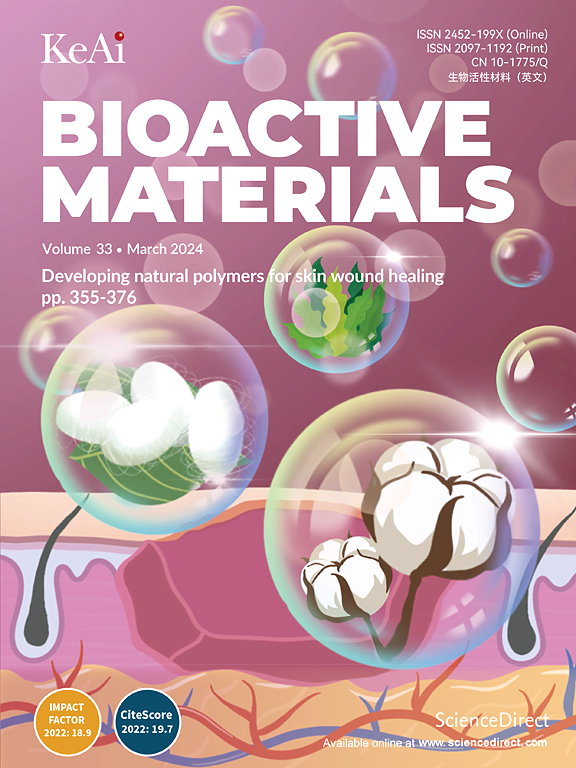Three-stage sequential targeted nasal drops for correcting abnormal mitochondrial division in microglia
IF 18
1区 医学
Q1 ENGINEERING, BIOMEDICAL
引用次数: 0
Abstract
Abnormal mitochondrial division in microglia significantly impacts central nervous system (CNS) diseases. However, treating CNS diseases through microglial mitochondria presents several challenges: intracerebral delivery of drugs, microglial targeting, and mitochondrial regulation. Herein, a novel three-stage sequential targeted nasal drops delivery system that achieves precise drug delivery to the core of brain lesions through noninvasive nasal delivery, targeting microglia, and regulating mitochondria were developed. Firstly, dehydroepiandrosterone (DHEA), identified from clinical data and transcriptomic analyses as a key neurosteroid regulating mitochondrial fission, was selected. Secondly, surface-positively charged hydrogel microspheres were prepared to adhere to the nasal mucosa, thereby avoiding rapid clearance and achieving the first stage of nasal mucosa targeting. Subsequently, targeted liposomes carrying cytotoxic T lymphocyte-associated protein-4 were constructed and modified into microspheres, which released liposomes through the nasal cavity to enter the brain and bound to the activated microglial surface receptors CD80/86 accomplishing the second stage of cell targeting. In the third stage, the system released DHEA in response to the microenvironment, precisely regulating dynamin-related protein 1 involved in mitochondrial membrane remodeling, which inhibited abnormal mitochondrial division, stabilized mitochondrial morphology and function, inhibited microglial activation. This study demonstrated that three-stage sequential nasal drops efficiently traversed the nose-to-brain pathway via nasal mucosa in both murine (n = 200) and porcine (n = 16) models, while significantly ameliorating anesthesia/surgery-induced cognitive dysfunction in mice. Therefore, the three-stage sequential nasal drip is a promising method for the treatment of central nervous system diseases.

三期序贯靶向滴鼻液纠正小胶质细胞线粒体分裂异常
小胶质细胞线粒体分裂异常对中枢神经系统(CNS)疾病有显著影响。然而,通过小胶质细胞线粒体治疗中枢神经系统疾病存在一些挑战:脑内药物递送、小胶质细胞靶向和线粒体调节。本研究开发了一种新型的三期顺序靶向滴鼻给药系统,通过无创鼻腔给药,靶向小胶质细胞,调节线粒体,实现对脑病变核心的精确给药。首先,从临床数据和转录组学分析中确定脱氢表雄酮(DHEA)是调节线粒体裂变的关键神经类固醇。其次,制备表面带正电的水凝胶微球粘附在鼻黏膜上,避免快速清除,实现鼻黏膜靶向的第一阶段。随后,构建携带细胞毒性T淋巴细胞相关蛋白-4的靶向脂质体并修饰成微球,微球通过鼻腔释放脂质体进入大脑,与活化的小胶质表面受体CD80/86结合,完成第二阶段的细胞靶向。第三阶段,系统响应微环境释放脱氢表雄酮,精确调节参与线粒体膜重塑的动力蛋白相关蛋白1,抑制线粒体异常分裂,稳定线粒体形态和功能,抑制小胶质细胞活化。本研究表明,在小鼠(n = 200)和猪(n = 16)模型中,三段式顺序滴鼻液有效地通过鼻黏膜穿过鼻到脑通路,同时显著改善了麻醉/手术诱导的小鼠认知功能障碍。因此,三级序贯滴鼻是治疗中枢神经系统疾病的一种很有前途的方法。
本文章由计算机程序翻译,如有差异,请以英文原文为准。
求助全文
约1分钟内获得全文
求助全文
来源期刊

Bioactive Materials
Biochemistry, Genetics and Molecular Biology-Biotechnology
CiteScore
28.00
自引率
6.30%
发文量
436
审稿时长
20 days
期刊介绍:
Bioactive Materials is a peer-reviewed research publication that focuses on advancements in bioactive materials. The journal accepts research papers, reviews, and rapid communications in the field of next-generation biomaterials that interact with cells, tissues, and organs in various living organisms.
The primary goal of Bioactive Materials is to promote the science and engineering of biomaterials that exhibit adaptiveness to the biological environment. These materials are specifically designed to stimulate or direct appropriate cell and tissue responses or regulate interactions with microorganisms.
The journal covers a wide range of bioactive materials, including those that are engineered or designed in terms of their physical form (e.g. particulate, fiber), topology (e.g. porosity, surface roughness), or dimensions (ranging from macro to nano-scales). Contributions are sought from the following categories of bioactive materials:
Bioactive metals and alloys
Bioactive inorganics: ceramics, glasses, and carbon-based materials
Bioactive polymers and gels
Bioactive materials derived from natural sources
Bioactive composites
These materials find applications in human and veterinary medicine, such as implants, tissue engineering scaffolds, cell/drug/gene carriers, as well as imaging and sensing devices.
 求助内容:
求助内容: 应助结果提醒方式:
应助结果提醒方式:


